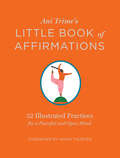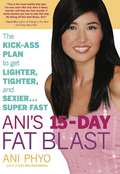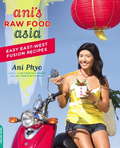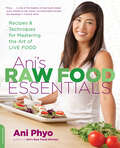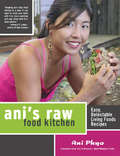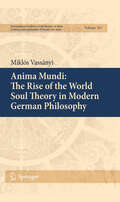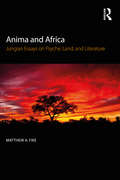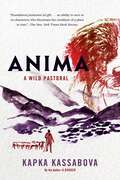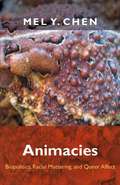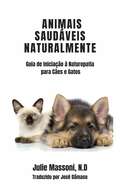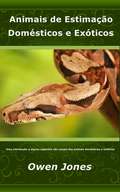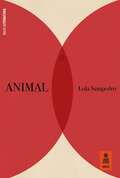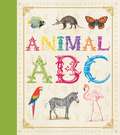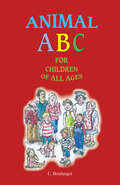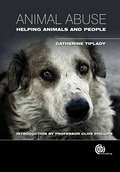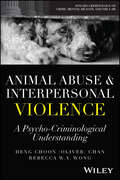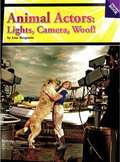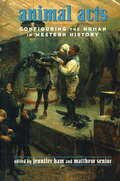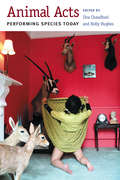- Table View
- List View
Ani Trime's Little Book of Affirmations: 52 Illustrated Practices for a Peaceful and Open Mind
by Ani Trime“Every thought I think is creating my future.” So begin the 52 affirmations of Ani Trime, a beloved teacher in the Tibetan Buddhist tradition who began her own life as a gruff, plainspoken West Virginian. Noted for her humor and no-nonsense approach to spiritual practice, Trime offers wise uplifting affirmations that will resonate with everyone. Collected in an appealing, pocket-size volume, Ani Trime’s Little Book of Affirmations features original illustrations created by 39 well-known contemporary commercial artists. This publication conforms to the EPUB Accessibility specification at WCAG 2.0 Level AA.
Ani's 15-Day Fat Blast
by Ani PhyoLooking for that one miracle diet that will simply melt pounds away? Here it is. Premiere raw food chef Ani Phyo breaks down the myths and preconceptions of eating raw and offers a revolutionary, easy plan to help you shed up to fifteen pounds in just fifteen days simply by eating delicious raw meals. The plan is simple: eat up and speed up the fat burning and weight loss by using simple, living, and all-natural ingredients with Ani’s signature recipes. Look forward to not only losing weight, but also building muscle, boosting endurance, slowing down aging, and feeling energized all day long.
Ani's 15-Day Fat Blast
by Ani PhyoFrom the author of "AniOCOs Raw Food Kitchen": an easy diet plan using raw foods for health, beauty, weight loss, and overall well-beinga"
Ani's Raw Food Asia: Easy East-West Fusion Recipes the Raw Food Way
by Ani PhyoYou've been to her kitchen, enjoyed her desserts, and mastered the essentials; now go with raw food goddess Ani Phyo back to her roots for the first ever Asian raw food cookbook. Along with recipes from Korea, China, Japan, Thailand, Vietnam, India, Indonesia, and Hawaii and background information on traditional dishes, Ani's Raw Food Asia also offers essential tips on green living, well-being, longevity, fitness, beauty, and entertaining as inspired by a healthy Asian lifestyle. Recipes include: Mixed Vegetable Skewers with Almond-Butter Sauce, Creamed Curry Saag, Vegetable Tempura with Orange Lemongrass Dipping Sauce, Marinated Shiitake Mushroom Dumplings, Corn Fritters with a Hot and Sour Cucumber Dipping Sauce, Dosas, Moo Shoo Vegetables, and more.
Ani's Raw Food Desserts: 85 Easy, Delectable Sweets and Treats
by Ani PhyoFrom the author of "AniOCOs Raw Food Kitchen"?a full-color, giftable collection of raw sweets and treats recipes, a la "Vegan Cupcakes Take Over the World""
Ani's Raw Food Detox [previously published as Ani's 15-Day Fat Blast]: The Easy, Satisfying Plan to Get Lighter, Tighter, and Sexier . . . in 15 Days or Less
by Ani PhyoWant to look younger and feel better?Want to increase your energy levels, build lean muscle, and enhance immunity?Want to do all this while eating delicious, easy meals that will leave you feeling satisfied and full of energy?Welcome to Ani's Raw Food Detox. Award-winning chef, health coach, and consultant Ani Phyo offers an easy, delicious 15-day program based on nature's real "fast foods." The plan is simple: eat up and speed up the cleansing, detoxing, and fat-burning process by using all-natural whole food ingredients. Watch the pounds fly off as you gain boundless energy and clear, radiant skin while at the same time lowering your risk for chronic diseases. Designed to help you get optimal results and achieve your detoxing and immune-boosting goals, Ani's Raw Food Detox offers:Top detox and fat-fighting strategies and toolsLists of foods that accelerate cleansing, detox, and your metabolismMore than 50 quick, easy, delicious recipesMenus and shopping lists for each phase of the planStrategies for long-term health and maintenance
Ani's Raw Food Essentials
by Ani PhyoChef Ani Phyo is back with Ani's Raw Food Essentials, full of everything you need to know to master the art of live food. Phyo shows you how to whip up simple, fresh recipes using what you've already got in your kitchen while also offering tips on dehyrating and more sophisticated techniques. Looking for innovative meals that are healthy and delicious? Phyo offers everything from classic comfort foods like nachos and burgers to Reuben sandwiches and bacon, along with more gourmet dishes like risotto, angel hair pasta, and her "you-won't-believe-they're-raw" desserts.Ani's Raw Food Essentials once again proves that you don't have to sacrifice taste to reap the benefits of raw foods, all while living a greener lifestyle. Recipes include: Broccoli and Cheeze Quiche, Kalamata Olive Crostini, Cashew "Tofu" in Miso Broth, Grilled Cheeze and Tomato Sandwiches, Cheeze Enchilada with Ranchero and Mole Sauce, Pad Thai, Pesto Pizza, and many more.
Ani's Raw Food Essentials
by Ani PhyoFrom the author of Ani's Raw Food Kitchen (over 45,000 copies sold) and Ani's Raw Food Desserts, comes the go-to book for all things raw.
Ani's Raw Food Essentials: Recipes and Techniques for Mastering the Art of Live Food
by Ani PhyoFrom the author of "AniOCOs Raw Food Kitchen" (over 45,000 copies sold) and "AniOCOs Raw Food Desserts," comes the go-to book for all things raw. "
Ani's Raw Food Kitchen: Easy, Delectable Living Foods Recipes
by Ani PhyoThis is the ultimate gourmet, living foods "uncookbook" for busy people. You don't have to sacrifice taste or style to reap the benefits of raw foods. These delectable, easy recipes emphasize fresh, animal-free ingredients and how to include more organics into your daily diet. Chef Ani offers delicious raw, animal-free versions of: breakfast scrambles, pancakes, chowders, bisques, and other soups, cheezes, mylks, lasagna, burgers, cobblers, pies, and cakes, and more. Included are recipes for dishes such as Stuffed Anaheim Chili with Mole Sauce, Ginger Almond Nori Roll, Coconut Kreme Pie with Carob Fudge on Brownie Crust, Mediterranean Dolmas, and Chicken-Friendly Spanish Scramble. Make your own kitchen more living-foods friendly with Chef Ani's tips on Essential tools, Key ingredients, Stocking your pantry, and How-to kitchen skills.
Anima Mundi: The Rise Of The World Soul Theory In Modern German Philosophy (International Archives of the History of Ideas Archives internationales d'histoire des idées #202)
by Miklós VassányiThis work presents and philosophically analyzes the early modern and modern history of the theory concerning the soul of the world, anima mundi. The initial question of the investigation is why there was a revival of this theory in the time of the early German Romanticism, whereas the concept of the anima mundi had been rejected in the earlier, classical period of European philosophy (early and mature Enlightenment). The presentation and analysis starts from the Leibnizian-Wolffian school, generally hostile to the theory, and covers classical eighteenth-century physico-theology, also reluctant to accept an anima mundi. Next, it discusses early modern and modern Christian philosophical Cabbala (Böhme and Ötinger), an intellectual tradition which to some extent tolerated the idea of a soul of the world. The philosophical relationship between Spinoza and Spinozism on the one hand, and the anima mundi theory on the other is also examined. An analysis of Giordano Bruno's utilization of the concept anima del mondo is the last step before we give an account of how and why German Romanticism, especially Baader and Schelling asserted and applied the theory of the Weltseele. The purpose of the work is to prove that the philosophical insufficiency of a concept of God as an ens extramundanum instigated the Romantics to think an anima mundi that can act as a divine and quasi-infinite intermediary between God and Nature, as a locum tenens of God in physical reality.
Anima and Africa: Jungian Essays on Psyche, Land, and Literature
by Matthew A. FikeC. G. Jung understood the anima in a wide variety of ways but especially as a multifaceted archetype and as a field of energy. In Anima and Africa: Jungian Essays on Psyche, Land, and Literature, Matthew A. Fike uses these principles to analyze male characters in well-known British, American, and African fiction. Jung wrote frequently about the Kore (maiden, matron, crone) and the "stages of eroticism" (Eve, Mary, Helen, Sophia). The feminine principle’s many aspects resonate throughout the study and are emphasized in the opening chapters on Ernest Hemingway, Henry Rider Haggard, and Olive Schreiner. The anima-as-field can be "tapped" just as the collective unconscious can be reached through nekyia or descent. These processes are discussed in the middle chapters on novels by Laurens van der Post, Doris Lessing, and J. M. Coetzee. The final chapters emphasize the anima’s role in political/colonial dysfunction in novels by Barbara Kingsolver, Chinua Achebe/Nadine Gordimer, and Aphra Behn. Anima and Africa applies Jung’s African journeys to literary texts, explores his interest in Haggard, and provides fresh insights into van der Post’s late novels. The study discovers Lessing’s use of Jung’s autobiography, deepens the scholarship on Coetzee’s use of Faust, and explores the anima’s relationship to the personal and collective shadow. It will be essential reading for academics and scholars of Jungian and post-Jungian studies, literary studies, and postcolonial studies, and will also appeal to analytical psychologists and Jungian psychotherapists in practice and in training.
Anima: A Wild Pastoral
by Kapka KassabovaIn Anima, Kapka Kassabova introduces us to the “pastiri” people—the shepherds struggling to hold on to an ancient way of life in which humans and animals exist in profound interdependence. Following her three previous books set in the Balkans, and with an increasinging interest in the degraded state of our planet and culture, Kassabova reaches further into the spirit of place than she ever has before. In this extraordinary portrayal of pastoral life, she investigates the heroic efforts to sustain the oldest surviving breeds of our domesticated animals, and she shows us the epic, orchestrated activity of transhumance—the seasonal movement, on foot, of a vast herd of sheep, working in tandem with dogs. She also becomes more and more attuned to the isolation and sacrifices inherent in the lives shaped by this work.Weaving together lyrical writing about place with a sweeping sense of the traumatic histories that have shaped this mountainous region of Bulgaria, Kassabova shows how environmental change and industrial capitalism are endangering older, sustainable ways of living, and by extension she reveals the limited nature of so much of modern life. But shining through Kassabova’s passionate, intimate response to the monoculture that is “Anthropos” is her indelible portrait of a circulating interdependence of people and animals that might point to a healthier way to live.
Animacies: Biopolitics, Racial Mattering, and Queer Affect (Perverse Modernities: A Series Edited by Jack Halberstam and Lisa Lowe Ser.)
by Mel Y. ChenIn Animacies, Mel Y. Chen draws on recent debates about sexuality, race, and affect to examine how matter that is considered insensate, immobile, or deathly animates cultural lives. Toward that end, Chen investigates the blurry division between the living and the dead, or that which is beyond the human or animal. Within the field of linguistics, animacy has been described variously as a quality of agency, awareness, mobility, sentience, or liveness. Chen turns to cognitive linguistics to stress how language habitually differentiates the animate and the inanimate. Expanding this construct, Chen argues that animacy undergirds much that is pressing and indeed volatile in contemporary culture, from animal rights debates to biosecurity concerns. <P><P>Chen's book is the first to bring the concept of animacy together with queer of color scholarship, critical animal studies, and disability theory. Through analyses of dehumanizing insults, the meanings of queerness, animal protagonists in recent Asian/American art and film, the lead in toys panic in 2007, and the social lives of environmental illness, Animacies illuminates a hierarchical politics infused by race, sexuality, and ability. In this groundbreaking book, Chen rethinks the criteria governing agency and receptivity, health and toxicity, productivity and stillness—and demonstrates how attention to the affective charge of matter challenges commonsense orderings of the world.
Animais Saudáveis Naturalmente Guia de Iniciação à Naturopatia para Cães e Gatos
by Julie MassoniSinopse Animais Saudáveis Naturalmente é um guia introdutório à naturopatia para cães e gatos e inclui informações sobre dieta natural, suplementos nutricionais para melhorar a sua saúde dos animais, juntamente com informações sobre o uso de ervas, homeopatia e essências florais para ajudar na saúde e no bem-estar. Alternativas naturais para pulgas, desparasitação, antibióticos e alívio da dor. Também inclui informações sobre a alimentação e de uma dieta vegetariana para cães. Escrito por um naturopata de animais qualificado, que tem ajudado milhares de animais com uma série de questões de saúde agudas e crónicas. Se gostaria de saber mais sobre como usar terapias naturais e como evitar muitos problemas de saúde, então, este livro é uma grande referência.
Animais de Estimação Domésticos e Exóticos: Uma introdução a alguns aspectos não usuais dos animais domésticos e exóticos (Como se faz... #31)
by Owen JonesAnimais de Estimação Domésticos e Exóticos Uma introdução a alguns aspectos não usuais dos animais domésticos e exóticos Espero que você ache estas informações relevantes, úteis e valiosas. As informações neste e-book, sobre vários aspectos de animais de estimação exóticos ou não, estão organizadas em 17 capítulos de aproximadamente 500-600 palavras cada. Espero que isto desperte o interesse em quem ama os animais. Como bônus, estou lhe dando a permissão para que use este conteúdo em seu próprio website ou em seu próprio blog ou newsletter, apesar de ser melhor que você o reescreva primeiro com suas próprias palavras. Você também pode dividir este livro e revender os artigos. Na verdade, o único direito que você não tem é revender ou jogar fora um livro que foi dado a você.
Animal
by Lola SampedroUn viaje personal inesperado, la revolución silenciosa de una mujer que tendrá que arrancar todas las costras de su cuerpo, una a una, para poder por fin mudar de piel.
Animal ABC
by Susi MartinAn introduction to the alphabet and the animal kingdom. This charming book introduces children to every letter in the alphabet. Beautiful watercolor illustrations on every page will engage and delight children, with a variety of animals for children to spot, from aardvarks and alligators to zebras. Children love animals and take pride in identifying them. Animal ABC is sure to engage young minds.
Animal ABC for Children of All Ages
by C. BoulangerWhen COVID-19 lockdowns swept the globe, creativity unlocked for one woman in Belleville, Ontario. Alone with her cat, C. Boulanger turned to a fantasy world she had long imagined, bringing to life a charming children&’s tale. With whimsical animals as guides straight from her isolation, she penned Animal ABC for Children of All Ages not just to delight young readers, but to remind all of us that even in the darkest of days, joy and wonder still exist if only we know where to look. Brighten your family&’s time at home with this playful journey of imagination.Cover designed by Janet Eastwood.
Animal Abuse
by Catherine TipladyAnimal abuse affects everybody working in animal-related industries, and constitutes a significant part of veterinary caseloads and animal shelter work. Based on the author's experience as a shelter worker and veterinarian, this book provides advice and assistance to those working with animal abuse. Beginning with definitions and types of abuse that occur worldwide in domestic, industry, leisure and cultural settings, the book goes on to detail current topics of debate such as foie gras production, pedigree dog breeding, links between animal abuse and domestic violence, and the fascinating subject of veterinary forensics - the scientific investigation of instances of animal abuse. The book's practical focus is developed through interviews with people in a variety of affected roles, international case studies, and discussion of the difficulties that arise; how they can be dealt with and the mental health impacts they can have on those involved. With contributions from world-renowned experts including Phil Arkow and David Bailey, and an introduction by Clive Phillips, Animal Abuse: Helping Animals and People provides practical advice and insights into issues surrounding this emotional subject.
Animal Abuse and Interpersonal Violence: A Psycho-Criminological Understanding (Psycho-Criminology of Crime, Mental Health, and the Law)
by Heng Choon Oliver Chan Rebecca W. Y. WongANIMAL ABUSE & INTERPERSONAL VIOLENCE A COMPREHENSIVE EXAMINATION OF THE CAUSES OF, AND LINKS BETWEEN, INTERPERSONAL AND INTERSPECIES VIOLENCE Animal Abuse & Interpersonal Violence: A Psycho-Criminological Understanding addresses the many aspects of the link between animal cruelty and human violence. Presenting new theory, research, policy, and practice, this authoritative volume explores the subject through a psycho-criminological lens to describe, explain, and potentially prevent intentional behavior that causes pain, suffering, or death in animals and humans. With an integrated theoretical-practical approach, Animal Abuse & Interpersonal Violence offers up-to-date research and provides real-world insights into current thinking in the study of animal abuse and interpersonal violence. Sixteen in-depth chapters by a multidisciplinary team of active researchers and experienced field practitioners examine central topics in the field, including different forms of animal exploitation, connections between animal cruelty and substance abuse, the association between childhood animal cruelty and adult interpersonal violence, the role of veterinarians in the identification of animal abuse cases, the complex legal aspects of animal abuse cases, and more. Advances scholarship on animal abuse, its relationship with interpersonal violence, and the psycho-criminological mechanisms involved in that relationship Introduces readers to contemporary research on a range of topics and issues related to animal abuse and interpersonal violence Examines the origins of animal cruelty, its societal implications, and various prevention and treatment approaches Defines and describes various types of animal maltreatment and their links to different forms of interpersonal violence Animal Abuse & Interpersonal Violence: A Psycho-Criminological Understanding is essential reading for practitioners, researchers, scholars, and advanced students in fields such as behavioral science, law, criminology, veterinary forensics, criminal justice, law enforcement, social work, sociology, social sciences, education, and animal welfare.
Animal Abuse: Helping Animals and People
by Catherine TipladyAnimal abuse affects everybody working in animal-related industries, and constitutes a significant part of veterinary caseloads and animal shelter work. Based on the author's experience as a shelter worker and veterinarian, this book provides advice and assistance to those working with animal abuse. Beginning with definitions and types of abuse that occur worldwide in domestic, industry, leisure and cultural settings, the book goes on to detail current topics of debate such as foie gras production, pedigree dog breeding, links between animal abuse and domestic violence, and the fascinating subject of veterinary forensics - the scientific investigation of instances of animal abuse. The book's practical focus is developed through interviews with people in a variety of affected roles, international case studies, and discussion of the difficulties that arise; how they can be dealt with and the mental health impacts they can have on those involved. With contributions from world-renowned experts including Phil Arkow and David Bailey, and an introduction by Clive Phillips, Animal Abuse: Helping Animals and People provides practical advice and insights into issues surrounding this emotional subject.
Animal Actors: Lights, Camera Wolf! / Animals in Film: Cruelty on Camera (Fountas & Pinnell LLI Purple #Level W)
by Lisa BenjaminTWO WAY BOOK Animal Actors Lights Camera Wolf! & Animals in Film Cruelty on Camera by Lisa Benjamin
Animal Acts: Configuring the Human in Western History
by Jennifer Ham Matthew SeniorAnimal Acts records the history of the fluctuating boundary between animals and humans as expressed in literary, philosophical and scientific texts, as well as visual arts and historical practices such as dissection, circus acts, the hunt and zoos. The essays document a persistent return of animality, a becoming animal that has always existed within and at the margins of Western Culture from the Middle Ages to the present.
Animal Acts: Performing Species Today
by Holly Hughes Una ChaudhuriWe all have an animal story--the pet we loved, the wild animal that captured our childhood imagination, the deer the neighbor hit while driving. While scientific breakthroughs in animal cognition, the effects of global climate change and dwindling animal habitats, and the exploding interdisciplinary field of animal studies have complicated things, such stories remain a part of how we tell the story of being human. Animal Acts collects eleven exciting, provocative, and moving stories by solo performers, accompanied by commentary that places the works in a broader context. Work by leading theater artists Holly Hughes, Rachel Rosenthal, Deke Weaver, Carmelita Tropicana, and others joins commentary by major scholars including Donna Haraway, Jane Desmond, Jill Dolan, and Nigel Rothfels. Una Chaudhuri's introduction provides a vital foundation for understanding and appreciating the intersection of animal studies and performance. The anthology foregrounds questions of race, gender, sexuality, class, nation, and other issues central to the human project within the discourse of the "post human," and will appeal to readers interested in solo performance, animal studies, gender studies, performance studies, and environmental studies.
